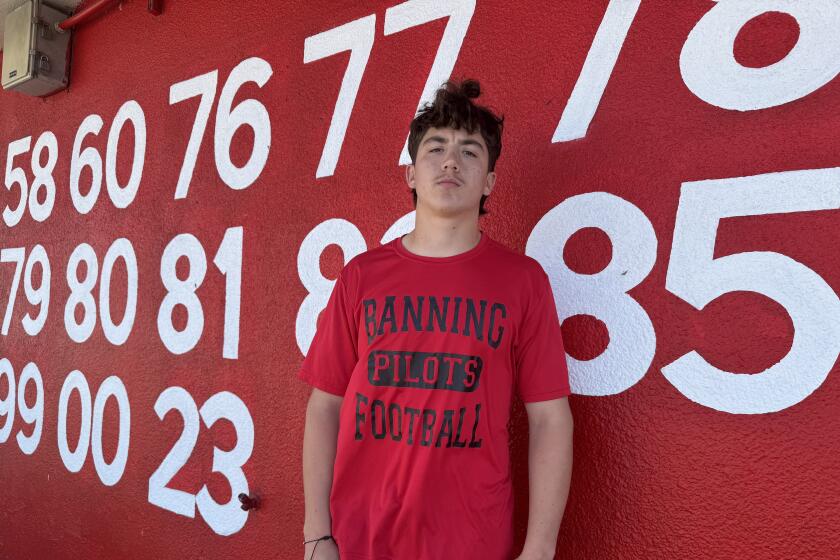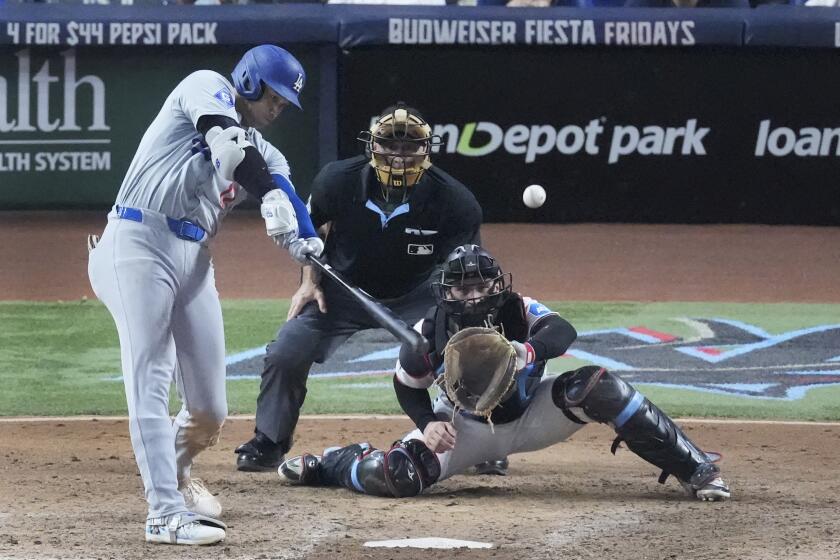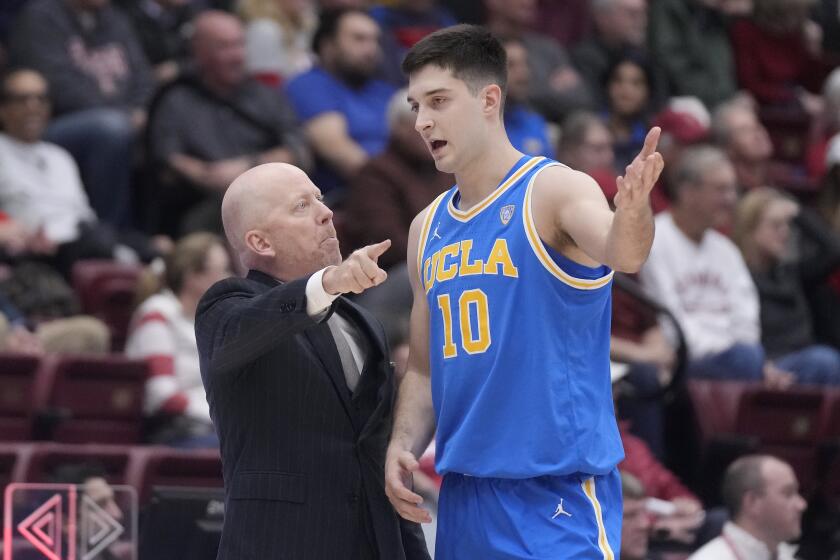They Also Win Who Only Stand and Serve
A year ago, after her tennis team came agonizingly close to winning the Southern California league title in Fountain Valley, Joan Saltzman knew what she had to do: recruit. She got one of the region’s veteran singles standouts--Rae Murbach--to join her squad.
“If you want to go to nationals,” Saltzman explained, “you’ve got to be tough at singles.”
Indeed, with her new whiz added to a lineup already stacked with top players from clubs such as Riviera, Malibu and Toluca Lake, Saltzman’s team--which plays out of the Braemar Country Club in Tarzana--went undefeated in the San Fernando Valley this spring. Then, last Sunday, the players had a pot-luck party to rally the forces, bought uniforms for more solidarity and set out to try again this weekend at the event that culminates league play throughout Southern California: The United States Tennis Assn.’s League Sectional Championships.
About 1,000 players are competing in Fountain Valley, having qualified by winning local leagues or regional playoffs from San Luis Obispo to San Diego.
“We’ve all come so far,” Saltzman said. “So we plan to win.”
You hear a lot from sports gurus about how tennis is slumping these days, especially in comparison to golf and Tigermania. And that is true to a degree: It’s not difficult to find an empty tennis court while the crowds are two deep at the driving range.
But before writing an obituary to tennis, stop by the courts of Fountain Valley’s Los Caballeros Sports Club. Organized league play is booming--participation in Southern California has jumped from 4,000 only five years ago to 14,500 now. Nationally, there are 300,000 entrants in the USTA adult team competitions, which began years ago as the “Volvo Leagues” and now are backed by Infiniti (tennis players still represent what the marketing experts call “good demographics.”)
The USTA’s local arm, the Southern California Tennis Assn. sponsors three other league seasons: fall competition in doubles only, a seniors (50 and over) league and a winter play for “mixed” (combined men’s and women’s) teams. But by far the most popular is the spring league, culminating in these playoffs, which has teams of only men or women squaring off in both singles and doubles.
Though there’s an “open” class playoff here that attracts a few teams of near tour-quality pros and former All-Americans, the leagues themselves start at the 5.0 level, which draws many teaching pros. But the big numbers only begin turning out at the 4.5 level (generally the top players at many clubs) and play continues downward in .5 increments, all the way to leagues for 2.5-level players, beginners.
The classifications are an attempt by tennis officials to standardize play nationally with the equivalent of the golf handicap system so a player from Atlanta can be compared, say, to one from Anaheim.
In the early days, cheating was rampant: with young players just off college teams sneaking into the 4.5 leagues, for instance, to dominate play. Now, to make the system work, more than a dozen “raters”--several from other parts of the country--roam the courts to evaluate every player competing, each of whom has a number fixed to his or her shirt.
Then there’s Theris Brown and his computers--it takes two laptops to hold all his tennis data.
Brown, 67, is a pro, college coach and parks director from Barstow who supervises the region’s ratings, maintaining a data base for 35,000 local players. His laptops log hundreds of thousands of match results from leagues such as these, age-group tournaments and even club tournaments in some locales.
So many matches are tracked by Brown, he needs help from his wife and two children. But they’re credited with making it harder for “ringer” players to slip into the leagues--not that teams don’t try.
Some have tried to have impostors slip in under a regular player’s name to secure a crucial win. Or a top player may intentionally drop a match so he won’t be moved up to a tougher league the next season.
“It reached the point where we were requiring every team to have a photo of their entire team,” tournament director Annette Buck said. “But that was an incredible inconvenience for thousands of players just to catch one or two cheats.”
Such is the pressure here and at 16 other sectionals conducted by the USTA around the nation to determine who qualifies for the national championships. The tennis governing body spends $2 million on those competitions alone, drawn from $15 league fees. Some league players will wind up competing at the same courts in New York where the U.S. Open soon will be played.
The national playoffs at Saltzman’s level, 4.5, will be in Mobile, Ala., in October. And as play began here Thursday, it looked as if her new player might be the key to getting there--Murbach swept to victory at the No. 1 singles spot in the opening match against the San Diego champions. But each team match consists of five contests--two in singles and three in doubles--and the San Diego women proved slightly tougher at the other positions.
Though Saltzman’s San Fernando Valley champions easily swept their next match, against the Ventura County representatives, San Diego seemed in the driver’s seat to make the final playoffs on Sunday, when the top two teams in each flight battle it out for the right to represent Southern California in the nationals.
“On that final day, you’ll see an awful lot of electricity,” Buck said. “With all these winning teams coming together, it’s like the freshman class at Stanford.”
More to Read
Go beyond the scoreboard
Get the latest on L.A.'s teams in the daily Sports Report newsletter.
You may occasionally receive promotional content from the Los Angeles Times.










